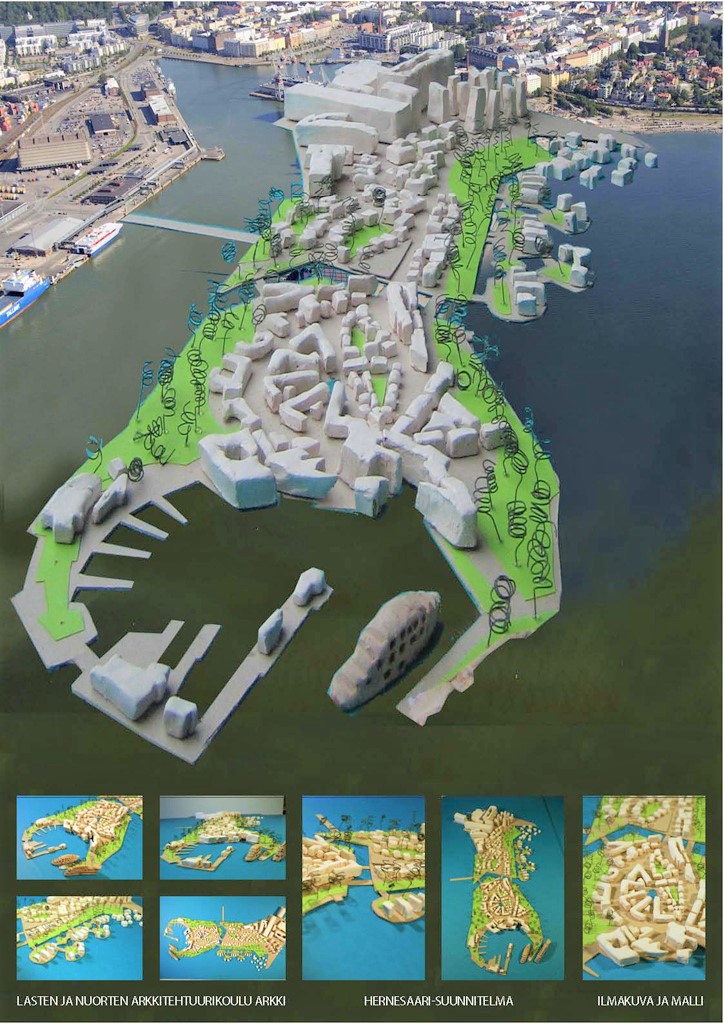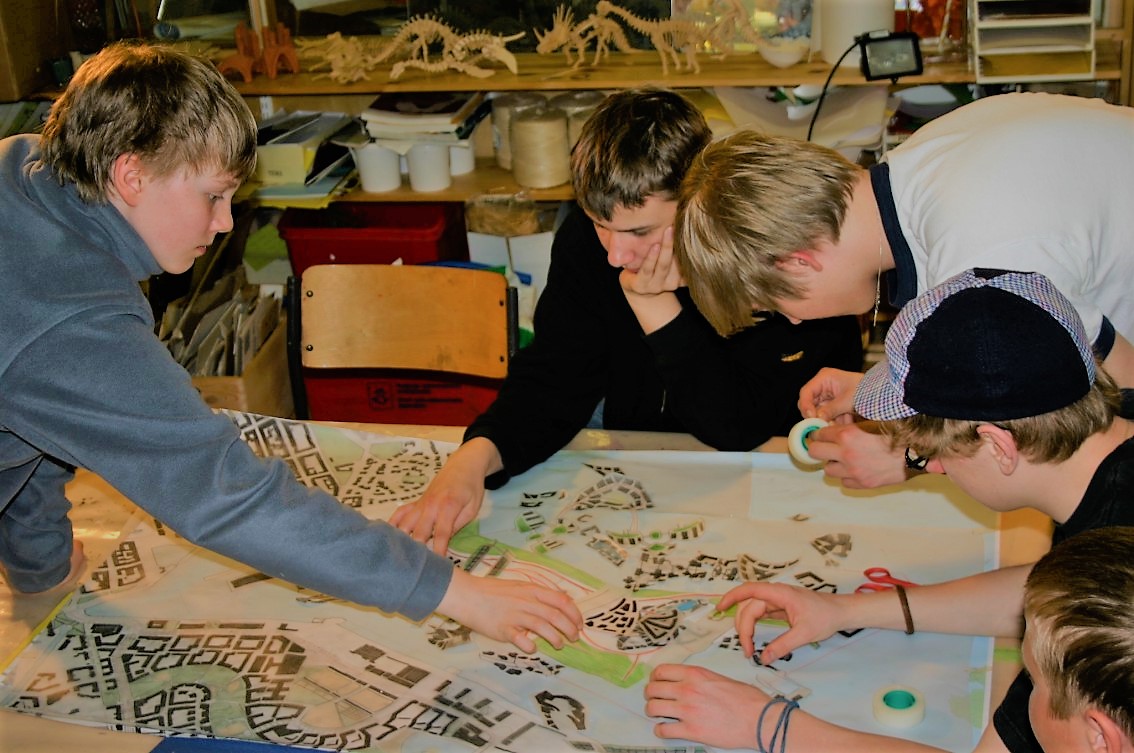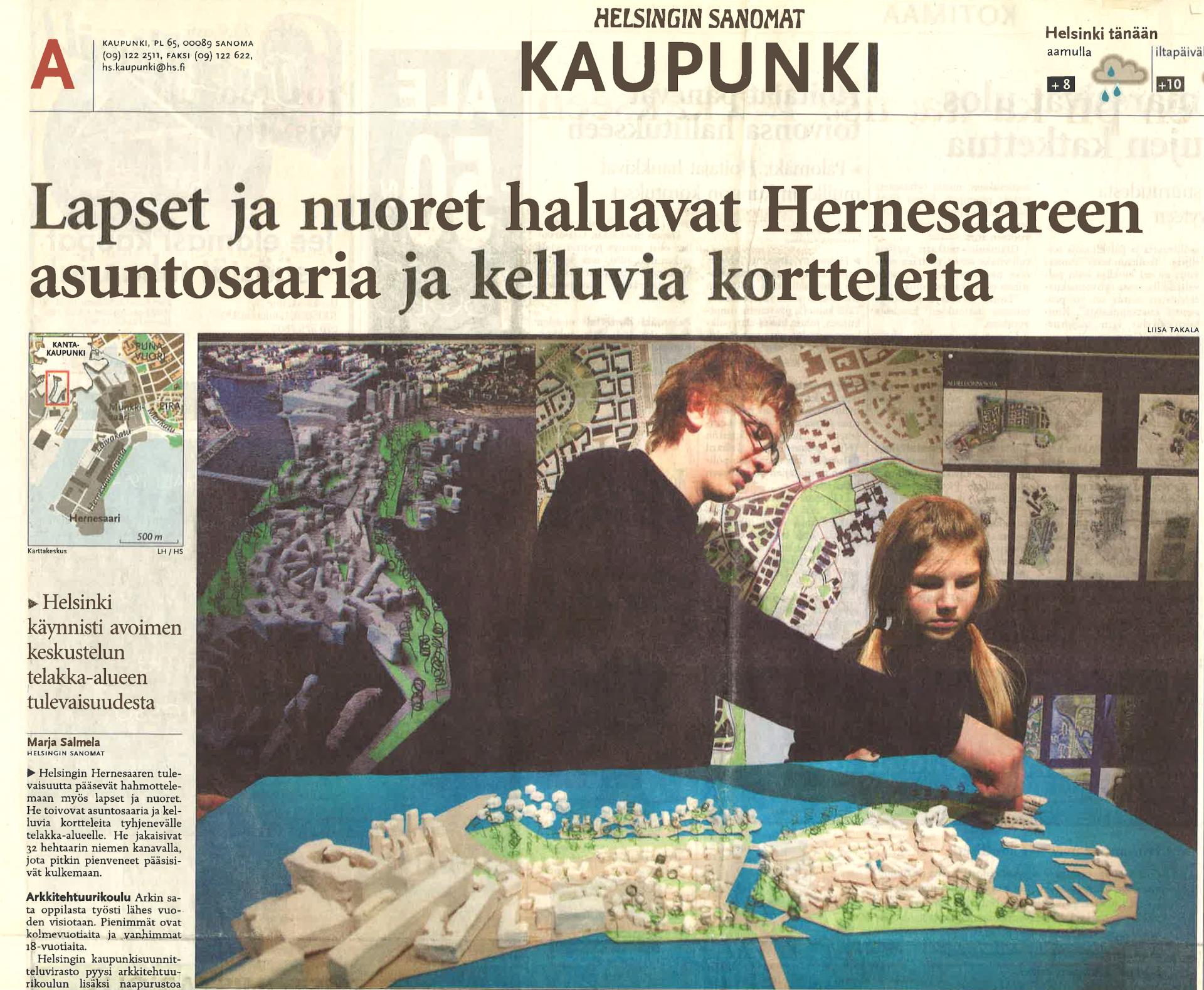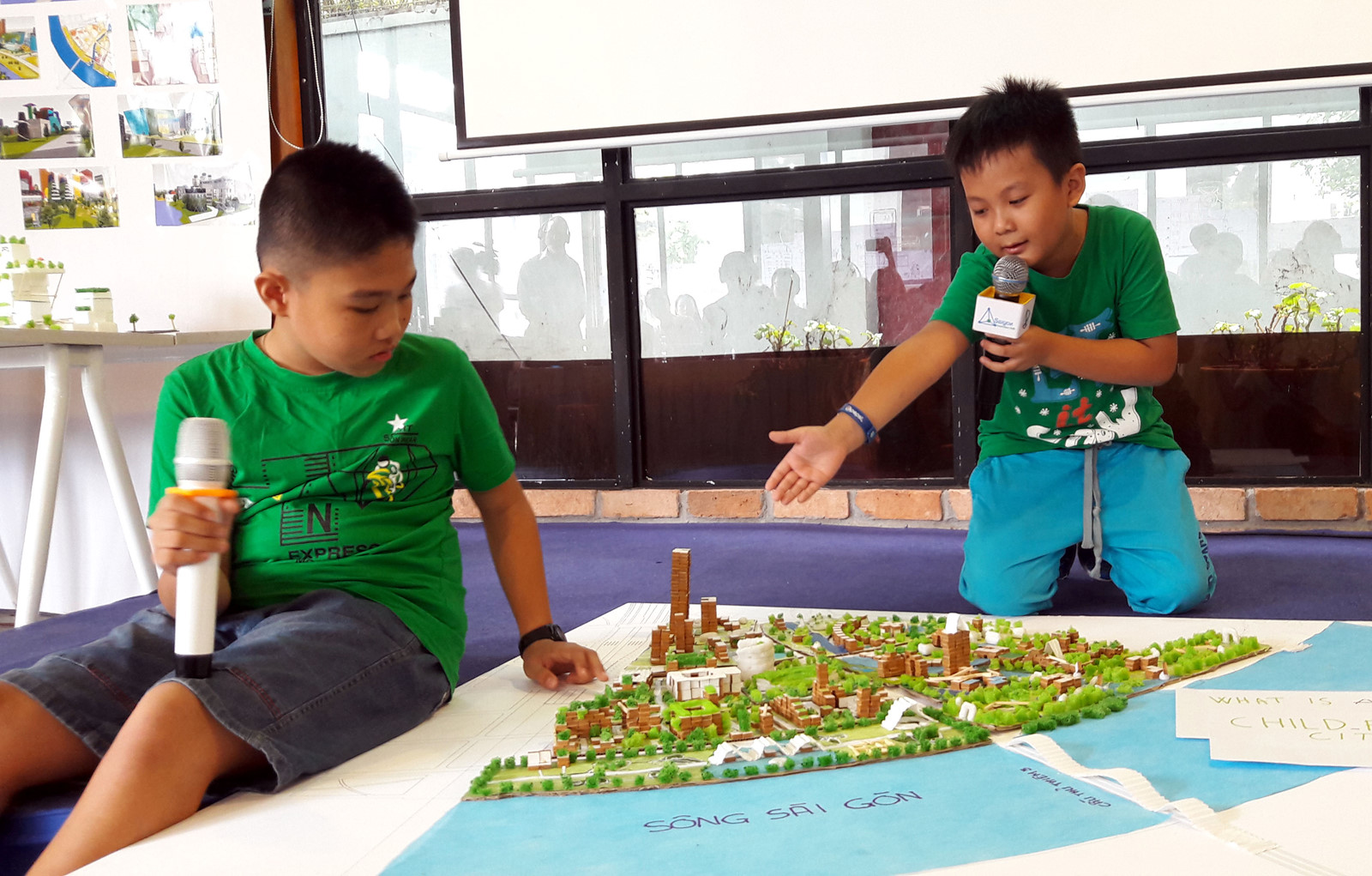Arkki´s Learning Via Participation Model
Basic information
Project Title
Full project title
Category
Project Description
Children are notable users, future creators and decision-makers of our cities! Arkki’s Learning Via Participation model enables children to positively influence their environment through a real democratic urban design process. Refined for a decade, it provides a more inclusive, sustainable and participatory decision making model to be implemented anywhere. Authorities, architects, and children working together enable transfer of knowledge and inclusion of viewpoints of various interest groups.
Project Region
EU Programme or fund
Description of the project
Summary
Arkki´s Learning Via Participation Model provides children with knowledge and tools to influence their environment. It introduces means for being a conscious and cooperative citizen. At the same time, it provides a more inclusive and participatory decision making and planning process for the community. Authorities, architects, and children working together ensure the transfer of knowledge and viewpoints of various interest groups; and architecture as a multidisciplinary phenomenon intertwining science, technology and arts, combined with meaningful participation in real-world design processes, reinforces cross-curricular learning.
The first implementation of the model was in 2007 when children participated in co-ideating and co-designing the Hernesaari master plan with Helsinki City Planning Office. Arkki facilitated 100 children (4-18 year-old) to work on the project in groups of 12 for 30 hours each, altogether 500 hours. This pioneer project in Finland showed that children are interested in city planning and competent in discussing and evaluating multiple solutions. The project truly succeeded in finding out the perspective of the young and was followed by dozen other implementations.
The model is applicable to various contexts, which was tested in Vietnam (2018), and Bangkok (2020). Arkki´s Smart & Child-friendly City was the first participatory project in Vietnam ever engaging children with urban planning experts and decision-makers. 269 kids (7-17 y), some marginalised and underprivileged, engaged in developing sustainable and child-friendly city ideas in Ho Chi Minh. It received the Unicef Child-Friendly Cities Inspiration Award in the category Meaningful Child Participation.
Arkki (Reg. Assn.) in Finland has developed architecture education for 27 years, Arkki International develops and implements the concepts internationally. #ArkkiNEB project https://www.arkki.net/neweuropeanbauhaus/. brings children's viewpoints in #neweuropeanbauhaus co-creation
Key objectives for sustainability
The key objectives are; developing active citizenship skills, understanding of sustainability, developing the sense of cultural belonging and environmental relationship, and providing an opportunity to take part in a real democratic urban design process and influence the creation of one's own environment.
This participatory education model gives the participating children an important experience and understanding of a real-world design process, a unique experience of involvement, and inspires them to look at the built environment in a new way. For adults, this reminds, that our life is a continuum, and today's decisions affect the common future.
The program supports the formation of a personal relationship with the environment and the development of cultural identity. It aims to spark enthusiasm and interest in architecture, the environment, and surrounding society. We believe that enthusiasm creates a desire to ask questions, find out about things, and ultimately make a difference.
Children learn about sustainability from various points of view during participatory design processes depending on each case and local circumstances. They consider the sustainable aspects from single materials to urban solutions, be it the use of solar power or public transport. Children's experiences on creative participatory processes add important means to their inclusion toolkit for building a sustainable future.
An interesting observation is that children and youth seem to consider the sustainability aspect as much as, or even more than adults. In all of the implementations, the participating children have identified a wide range of challenges that need to be resolved to design and build a more sustainable environment and save our planet. They demonstrate a deep worry about the state of our environment.
Children have come up with fun, possible and realistic solutions, and innovations yet to be refined, and solutions to be developed in general.
Key objectives for aesthetics and quality
The Arkki model aims to support the development of a personal and community perception of beauty by promoting interest in architecture, sustainability, and aesthetic values.
The model holistically combines science, technology, engineering, mathematics, humanities and social sciences. The subjects intertwine through a step-by-step architectural and urban design process of c. 10 successive projects. A playful step-by-step process and collaborative language play a crucial role in encouraging children to think out of the box, express their creative ideas and turn those ideas into concrete visual proposals. Turning ideas into tangible models develops design thinking and prototyping skills, which they can use to express their ideas and visions.
Arkki model supports children's growth towards humanity and ethically responsible members of society. The learning process includes ethical, aesthetic, and ecological issues and guides to combine these aspects through design ideas and proposals and reflect and assess what is significant and valuable for oneself and others in life. Also the psychological effect of the built environment is considered – how does a good environment support our lives? People shape their lives by interacting with each other and the environment. The environment gives a stage to our lives and actions. We shape the environment, which then affects our lives.
The model develops the child´s knowledge in architecture and the built environment in general and lays the foundations for a socially and culturally sustainable future. It supports active citizenship, collaboration, and interaction between people, either children or adults, and learning, understanding and the ability to evaluate different points of view. Children learn to identify and describe their viewpoints, justify their opinions, listen to other's perspectives, and understand the diversity of defining beauty and the quality of the environment. Different viewpoints are supported and discussed.
Key objectives for inclusion
The key objectives in regard to inclusion and participation are
1. Genuine participation for all in urban planning. Enabling children’s voices to be heard
Children are important users of cities and their opinion is seldom taken into account when planning them. In all the real-life projects Arkki model has been implemented in, the role of participants has been important. Their opinions are listened to from the very beginning and taken into consideration through communication and collaboration with the authorities in charge of designing the area. The model includes interaction with decision-makers through visual, physical, written and oral presentations and discussions. Collaboration is agreed in advance and carried out as planned, so the participants have been able to truly be part of the democratic process of participation. The decision-makers have engaged well in the process, the media has showcased children's ideas, and the ideas have been realized.
2. Active Citizenship skills
The model promotes collaboration and engages children in critical evaluation and persistent problem-solving, leading to a deeper and comprehensive understanding of the built environment. Children, no matter their background, have shown great enthusiasm and become more active in e.g. following news about city planning. Some have continued to influence.
3. Multidisciplinary Learning
The Arkki model guides children to examine cities from various perspectives through multidisciplinary processes. The children uncover the complexity of issues related to planning a city for all , transportation, services, culture, housing, public buildings, recreation and land use. Simultaneously they learn about history, environmental viewpoints, and ecological design solutions. They develop their ideas in a mutual master plan and a 3D scale model through the collaborative design process. Parents, guardians and tutors have also become engaged and reinforce that the attitudes have changed.
Results in relation to category
The impacts of the Arkki model, learning through participation, can be viewed at individual, team, and community levels.
At the individual level, it is all about developing citizenship skills and being able to influence. The Arkki model has proven to provide a 30-hour framework for extensive interdisciplinary learning related to a real-life context. Through the creative design process, we combine the STEAM subjects and social sciences, and humanities. The model fosters pragmatics as well as enhances critical thinking, problem-solving, and communication skills. These, in turn, help develop a personal viewpoint, be it aesthetics, inclusion or sustainability.
It is all about peer learning and co-creation at the team level, learning from each other, and developing ideas as a team. The Arkki model provides the children with a real-life related framework to make a real difference by participating in a democratic planning process. Children develop their viewpoints collaboratively.
At the community level, it is all about interacting with all citizens/children, learning different viewpoints. For decision-makers, the Arkki model offers a pattern of interaction and inclusion with the new generation and makes their voices heard for decision-makers. It highlights the importance of the inclusion of different user groups.
Within 20 years, the Arkki model has been implemented two dozen times in partnership with local authorities like Thai Parliament, Espoo City, or HCMC Department of Planning, and organizations like Save the Children or UNICEF. These projects have been recognized locally and internationally; Arkki project in Vietnam won the Child-Friendly Cities Inspiration Award in Meaningful Child Participation Category: Children Innovate won UNICEF CFCI AWARD.
Read more about the processes of Hernesaari, https://designingwithchildren.net/db/hernesaari-masterplan, and Vietnam project: https://www.unicef.org/vietnam/press-releases/basic-urban-planning-children.
How Citizens benefit
In the Hernesaari master plan project, 100 children ideated and proposed numerous concepts on different scales, which were discussed with the decision-makers and considered with respect.
In this project, citizens could also comment on the ideas and design and indicate what they like. In the final design made by the Helsinki Urban Planning department, one can see many concepts and ideas also proposed by the children. These include a central public park located on the southern coastline, water between houses, tramline for public transport.
New winds are blowing. Previously the City Planning Department had put forward its own plans to the public. Now we are doing the reverse. We are listening to visions and dreams of the people [...] Hopefully [children and young people] will sense that it is possible to influence the environment. (Tuomas Rajajärvi, City Planning Department of Helsinki).
In the Vietnam implementation, for the first time ever, child participation in urban planning was realized, and the program successfully raised awareness of children's role in participation and solving social and ecological challenges. The project was reported in 87 news & TV reports.
The most astonishing result happened after the Arkki program, as some kids decided to continue to influence their own surroundings by ideating, building models, presenting designs, and searching for money to implement their ideas in their neighborhood. They used the knowledge and methods learned, presented their ideas to decision-makers, and received political and monetary support to transform a neighborhood house into an open playground and a study space, the front yard into a green space, and the nearby land into a garden for the community to grow vegetables. They also invited more friends in the community to join hands in executing the projects.
This story is a great reminder that relatively even a short educational program of 30 hours can make all the difference in life!
Innovative character
The Arkki model combines learning and participation and thus differs from pure educational projects or traditional participatory processes. The model is truly multidisciplinary and leads to a deeper understanding of the physical, social, and psychological relationship between man and the environment; The model is applicable to multiple situations on different scales or even to an imaginary site. The most impactful way to implement it is in collaboration with different stakeholders within a real-life project.
Through the Arkki model, the children learn to
- develop observation and investigation skills
- build aesthetic awareness
- understand the human and urban scale and density
- read, interpret and draw maps in various scales
- familiarise with the language of architecture
- deepen the relationship with the environment
- understand needs of different user groups
- brainstorm and sketch ideas in various ways
- discuss and select the best ideas democratically
- produce 3D models and prototypes
- present and justify opinions
We highly appreciate this program. It has educated us on space awareness and urban planning and supports children to experience the role and responsibility of urban planning experts through drawing and 3D modeling. This creative and educational program is suitable for the HCMC context and should be replicated in other urban settings in Viet Nam. (Mr. Nguyen Hong Van, Chief of Office, HCMC Department of Planning and Architecture)
The Arkki model is flexible and can be easily implemented in different contexts and countries even during Covid restrictions. New project in Finland is the Lahti Radio Hill Outdoor Park project, with Radio and TV Museum Foundation, in cooperation with the Ministry of Education and Culture, City of Lahti, and YLE (Finnish Broadcasting Company).
Our project on EU level, #ArkkiNEB for children highlights children’s viewpoints with 250 children from 5 different countries, visible at https://www.arkki.net/neweuropeanbauhaus/




